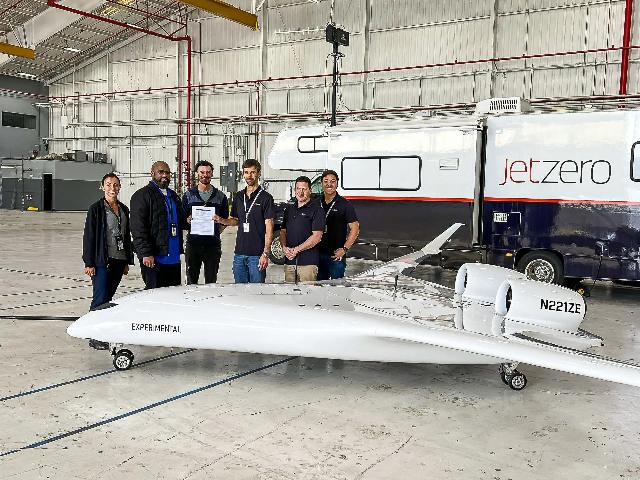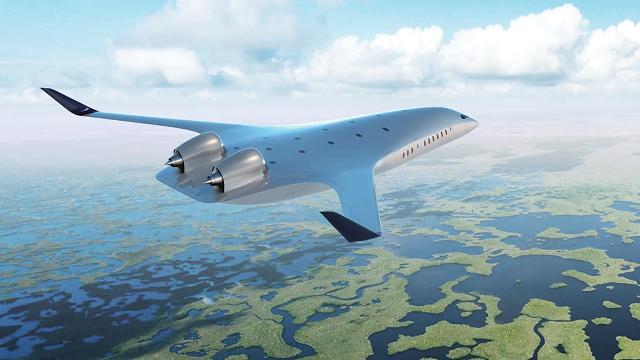The American company JetZero, which promises to make a splash in civil aviation, has received a certificate of airworthiness for testing a scaled-down copy of the ultra-efficient jet airliner with a "mixed wing" it is developing. The upcoming flight test program will be aimed at evaluating the flight performance of the aircraft, its stability and controllability.
Almost all aircraft, both modern and past, were assembled and are being assembled according to three classic aerodynamic schemes . The wing is mounted in such a way that it passes through the upper half of the fuselage of the aircraft (high-wing), through the lower part of the fuselage (low-wing) or in the center of the fuselage (mid-wing). From a technical point of view, these types of aircraft have a number of design differences, including the behavior of such machines in the air.
Since the second quarter of the 20th century (Soviet BEACH-3, 1926), engineers from different countries have been testing another aerodynamic scheme — the "flying wing", that is, tailless aircraft without a separate fuselage. With this scheme, all the components of the machine, as well as the pilots themselves, are located in the plane of the wing.
It is believed that this is the most aerodynamic and efficient design of all possible, but the "flying wing" has not been widely used in the global aircraft industry. Apparently, due to two significant drawbacks: large aircraft made according to this scheme may not be stable enough, besides they have low maneuverability. Nevertheless, modern automated aircraft control systems have solved the first problem, and the second for some classes of machines (passenger airliners) has never been particularly relevant.
In the 2000s, engineers started talking about another aerodynamic scheme, a kind of "flying wing" — a "mixed wing" . Unlike the first scheme, in this case the fuselage is clearly defined and smoothly transitions into triangular wing consoles. The fuselage and wing seem to merge together, forming an elegant shape that is a cross between an ordinary airliner and a "flying wing".
In 2016, Canadian scientists from the Institute of Aerospace Sciences at the University of Toronto conducted calculations of the fuel efficiency of the "mixed wing". They found that using such a scheme would achieve fuel savings of almost 11 percent, but only in cases with large aircraft. Further studies have shown that the "mixed wing" will have a 15 percent higher load capacity compared to machines designed according to classical aerodynamic schemes.
Today, private aerospace and military-industrial companies are mainly engaged in the creation of "mixed wing" devices. Among them are Airbus, Lockheed Martin, Bombardier, Zeroavia, as well as a small startup JetZero.
In 2023, JetZero representatives announced that the company's engineers were developing a Z5 jet airliner designed according to the "mixed wing" scheme. According to the developers, the car will use 50 percent less fuel (which is quite hard to believe) compared to modern passenger aircraft, which will significantly reduce operating costs and make transcontinental flights relatively cheap. In addition, the Z5 will be much more spacious than most airliners.
The new aircraft is designed to carry 250 passengers, its design will be able to withstand a higher pressure drop between the internal compartments and the external environment than conventional airliners. The cruising altitude will be approximately 14 thousand meters, the flight range will be almost 10 thousand kilometers, and the wingspan will be 61 meters.
The Z5 will be able to operate at any airport that is capable of handling most Airbus and Boeing aircraft. In addition, JetZero wants to make its mixed-wing aircraft 100 percent compatible with all possible types of SAF class fuels (Sustainable Aviation Fuel, that is, biofuels).
The wings or fuselage will also provide enough space to store the required amount of hydrogen as fuel (obviously, subject to a significant reduction in flight range).
The company plans to launch the Z5 into production as early as 2030 — presumably, it will replace the Boeing 757 and Boeing 767.
The other day JetZero shared important news . The US Federal Aviation Administration has issued the company with an airworthiness certificate for a scaled-down copy of the Z5 jet airliner. This is another step towards creating a full-fledged version of the aircraft.

A smaller copy of the Z5 jet airliner
Image source: JetZero
The demonstrator was named Pathfinder . This model has a scale of 1:8 (length is two meters, it is only 12.5 percent of the scale of a full—size aircraft) and a wingspan of seven meters. The upcoming Pathfinder flight test program will take place at airfields in Southern California, its purpose will be to test flight control systems and landing gear.
"In fact, all these tests are aimed at creating a full—scale demonstrator, the purpose of which is to prove the performance of an aircraft made according to the "mixed wing" scheme," the company explained.
JetZero is not only engaged in the development of an airliner for civil aviation, but also closely cooperates with the US military. In August 2023, the company signed a contract with the US Air Force worth $ 235 million to develop a tanker aircraft, which will be created according to the same scheme as the Z5. The company should build a prototype and begin its flight tests in 2027. If the prototype shows its best side, the Air Force will order its mass production. Otherwise, everything will be limited only to experienced equipment.


